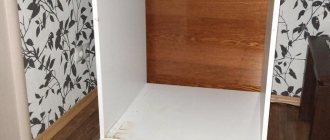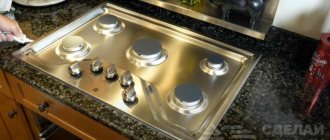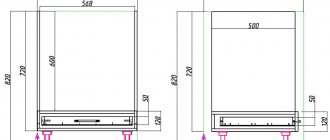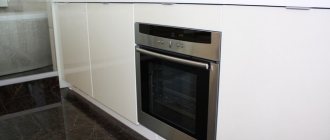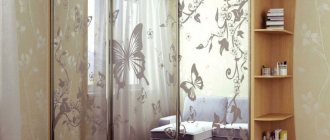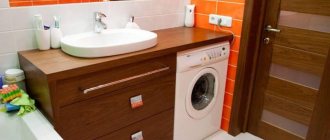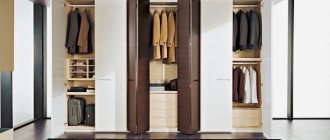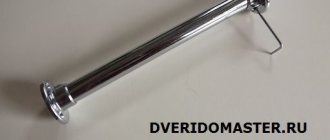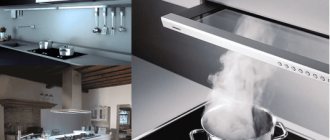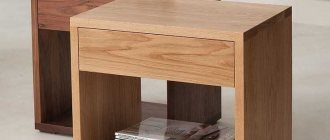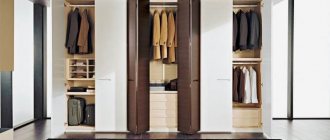Built-in kitchen appliances significantly save space and create coziness in the interior. The wide range of furniture modules for the kitchen is intimidating. But at the same time, you can create a unique design with a thoughtful layout of the work area.
I’ll tell you how to choose cabinets for the oven and hob, taking into account the size and features of the kitchen. We will discuss the working triangle rule, the location of sockets, connection safety, as well as combination with a washing machine and microwave oven.
Niche for built-in oven
Video: how to install a built-in hob into a table and connect it yourself
The video shows how the installation takes place on site:
The issue with a cabinet or cabinet for built-in appliances can be solved in 4 ways:
- buy complete with oven or hob;
- purchase as a separate element of the kitchen set;
- order from a furniture company;
- do it yourself.
In the first case, this happens infrequently: usually built-in appliances are sold without a box or countertop.
When purchasing furniture, you need to pay attention to the following point: the dimensions of the box should exceed the parameters of the oven by no more than 15-20 mm. This is a strict limitation that must be observed, otherwise problems will arise during operation or when installing the oven:
This is a strict limitation that must be observed, otherwise problems will arise during operation or when installing the oven:
- with a smaller gap between the walls of the box and the oven, there will be no air circulation, which will lead to overheating of the device;
- with a larger gap, problems will arise during installation.
When installing an electric stove, it is necessary to provide electrical wiring.
Video: how to choose a stove for cooking in the kitchen - options for dependent modules
The video shows the rule for choosing a dependent hob and oven:
Built-in appliances do not have a plug, but are connected directly to the electrical network.
The support for the unit must be strong and parallel to the floor. The design of the furniture purchased must match the style of the kitchen interior.
When manufacturing to order, any option can be provided, including corner placement. It is preferable to entrust the job to a professional than to do it yourself, since despite the simplicity of the design, installing the box and connecting it requires the knowledge and experience of an electrician.
But which stove is better, induction or electric, and what parameters should be used to select it, is indicated here.
Features and benefits of a kitchen with a built-in oven
An oven cabinet is a structure designed to accommodate an oven. It can either be part of a furniture set or purchased separately.
The advantages of a kitchen interior with a built-in oven include:
- visual appeal - such an interior looks much more elegant than a kitchen with a conventional oven;
- saving useful space;
- the ability to organize a “work triangle” (food preparation area) in a way that is convenient for the owners of the house;
- practicality - such furniture often combines several functions at once. For example, it can serve as a storage system.
But this solution also has features that must be taken into account when choosing:
- the cost of built-in appliances complete with furniture is higher than traditional ones;
- if the equipment is rearranged or fails, problems may arise: the oven will have to be changed along with the cabinet, since it will be difficult to find a structure that is suitable in size - usually the furniture is matched to the equipment, and not vice versa.
Peculiarities
Built-in household appliances today are both a tribute to fashion and the implementation of new opportunities provided by the modern construction industry. Widely used frame technology for building construction makes it possible to create large open spaces. It becomes possible to implement original design projects, but there are certain nuances. In an interior where the kitchen becomes part of the living room, and the living room is integrated with the kitchen, the unity of perception of the entire composition plays an important role.
The evolution of built-in appliances began with the revolutionary idea of dividing the oven and hob of a traditional stove into two separate appliances.
Today, the family of built-in appliances has expanded to include microwave ovens, coffee makers, and refrigerators, but in this article we will pay attention to the “hot shop”
What can a cabinet for a built-in oven contain?
A cabinet for a built-in oven can combine the functions of other household appliances:
- Microwave ovens (microwaves);
- hobs.
An oven with a microwave function has gained wide popularity due to its practicality and convenience. It allows you to use the oven as a microwave, and modern models are equipped with other operating modes - for example, defrosting, grilling, baking.
Structurally, this technique is an oven equipped with a magnetron - a microwave radiation generator.
Any oven can be combined with a hob. There are two options for this technique:
- dependent set - in it the cabinet and panel have a common control system;
- independent - in this case, the oven and panel are purchased separately.
The dependent set looks stylish and harmonious, but is inferior to the independent one in practicality - if it breaks down, the entire structure fails. In addition, in the latter case, it is possible to choose equipment that meets the needs of the housewife.
Oven functions
Once the choice has been made between a gas and electric oven, it is worth considering in more detail their capabilities and functions.
Material
Most often, doors are made in combination: metal and glass. But there are models that not only have a completely glass door, but also a control panel. This design does not provide any tangible advantages other than the original design. On the contrary, in case of an accidental impact the glass will break more easily.
Color
Often it is this that becomes the decisive argument when purchasing. The most common options: stainless steel cabinets, as well as cabinets coated with black and white enamel. However, the color palette of manufacturers is quite diverse; you can find yellow, blue, green, red and other models. It is worth considering that a cabinet of unusual colors will cost the buyer more than a standard silver one.
Cleaning system
One of the most important characteristics when choosing an oven. At the moment, there are 3 main ones: easy-to-clean enamel, pyrolysis and catalytic plates. Easy-to-clean enamel is the most budget-friendly and widespread option. On such a surface, dirt accumulates less and can be easily removed with a regular cloth and detergent. Catalytic plates are coated with a special compound that decomposes fat into water and carbon (soot). The disadvantage of this system is that the plates cover only part of the inner surface and have a limited service life of 5 years.
Pyrolysis cleaning is the most expensive and effective. When you turn on the mode, the oven heats up to 500 degrees and maintains this temperature for an hour. As a result, all mud deposits burn out and turn into soot, which can be easily removed with a rag. The disadvantages of cleaning, in addition to the high cost, are that it consumes a lot of electricity and an unpleasant burning smell appears during operation.
Number of glasses in the door
It's no secret that the oven that bakes best is the one that holds the heat better. Therefore, manufacturers in some models install not only 2, but also 3 and 4 glass doors. The air between the layers in such models serves as insulation. It not only retains heat inside the oven, but also does not allow the outside of the door to get too hot, making it safe for adults and small children.
Convection and grill
Convection is one of the most popular functions. A fan built into the back wall distributes heat throughout the entire volume of the chamber. This way, the baked goods are evenly baked on all sides, even if several sheets are placed in the oven at different levels at once.
The grill is an additional high-power heating element located in the upper part of the inner oven chamber. It can be either gas (burner) or electric (metal spiral) and allows you to bake food with the formation of a crust.
Display
As a rule, models with a display come with an automatic oven shut-off function. This means that you can set the cooking duration, end time of the program, add food and go about your business. It also displays the selected mode, temperature, and error messages.
Materials
The main requirements for furniture for built-in appliances are resistance to high temperatures, withstanding heavy weight, resistance to deformation and the absence of hazardous substances or odors when heated.
Materials for kitchen cabinets and the effect of temperature on them:
- Natural wood. Expensive material. Cons - cannot withstand high temperatures. The critical mark is + 95 degrees, otherwise fires may occur with greater heating.
- Chipboard. Wood chip boards are a popular material for budget furniture. The downside is that the surface does not react well to high humidity; phenol-formaldehyde resins of varying concentrations are used in production. The higher the level of formaldehyde in the composition, the more dangerous such furniture is, since the harmful substance will poison the air when the oven heats up. Hazard class - from E 0.5 to E 1 - allowed for children's furniture and living rooms. The manufacturer indicates this indicator in the certificate.
- MDF. This material, with equal thickness, is twice as strong as chipboard. Advantages: does not change shape when exposed to high temperatures when the oven heats up and does not release toxic substances into the air; it repels water and steam well.
For the back walls, you can use laminated plywood or fiberboard (hardboard).
Narrow and wide
Models for domestic use with a standard height (60 cm) can vary significantly in width. The narrowest of them are 45 cm. Such stoves usually have only basic functions, but they can be placed in a compact vertical module, such as a side cabinet, at tabletop level. A convenient option, especially relevant for families with small baking needs.
Despite its small size, the Maunfeld MEOXN.376RCC.TA oven costs about 50 thousand rubles
Wide ovens (up to 90 cm) are powerful, expensive devices capable of operating in a wide range of modes (12 or more). To install such a stove at the level of the working area, you will need a fairly large frame. Therefore, they are most often located in floor cabinets, below the countertop, under the hob.
An example of building a wide oven into a kitchen cabinet
Additional equipment for oven cabinets - storage and opening systems
Furniture under the oven can be used to store kitchen utensils.
For floor cabinets, the storage system is represented by an upper or lower drawer of limited height. Because of this, only certain items can be stored in it. For example, frying pans and baking sheets.
A pencil case has more possibilities for organizing a storage system - in it it can be represented by open shelves, drawers and compartments with doors.
Typically, the oven is built into the middle of the structure, so the storage compartments are located at the bottom or top.
In closed sections of the cabinet, various types of door opening mechanisms are used:
- swing doors are the simplest: the doors are attached to hinges and open towards you;
- folding - horizontal hinged system: open up or down;
- lifting - open using gas lifts.
How to correctly calculate furniture for an oven
When making calculations, you must first take into account the dimensions of the oven itself. This is essentially the starting point. Therefore, the choice of furniture should be preceded by the selection of equipment. Standards may vary:
- width 45-60 cm (in most cases);
- height up to 85 cm;
- depth on average 50-55 cm.
When the structures are located separately, there is no thermal discomfort.
The main thing is to equip a bedside table for the oven. And measurements are taken on the surface of the oven. Ideally, the nightstand should easily accommodate the oven. It is advisable to have a gap of 2-3 cm on the sides and top of the bedside table.
It is possible to distribute elements into different zones and use each individual component independently.
Advantages of built-in household appliances
Now kitchens designed for free-standing gas stoves can be confidently classified as economy class kitchens.
Another thing is a kitchen with a built-in hob and oven. The design of such a kitchen looks more holistic and beautiful. Due to the fact that all lower modules are covered with a single piece of tabletop, into which the hob and sink are embedded. And the oven is usually installed under the hob or placed in a kitchen cabinet.
It is worth noting that there must be a clean wall behind the cabinet in which the oven should be located (with a standard countertop depth of 600 millimeters). The fact is that the ovens have such dimensions in depth that they “fit” into the boxes designed for them - end to end.
Before inserting the electrical cabinet into the cabinet, it must be connected to the electrical supply, and then simply inserted into the opening. The cabinet itself in the niche is not secured with anything.
Modern electric ovens are currently less popular than gas ovens, although they have a number of advantages over the latter:
- They are environmentally cleaner.
- They are often made as microwave cabinets, in which you can quickly defrost meat or reheat food.
- Such cabinets are more functional.
- Electrical cabinets are very convenient to clean (the temperature inside the cabinet is raised to 300 degrees, and all food residues simply burn).
- The price of electric cabinets is higher than that of gas cabinets.
It is also worth noting one more limitation related to electrical cabinets. This is the location of the wiring in the room where the kitchen is to be installed. In some cases, it is simply not technically possible to install an electrical built-in cabinet.
Drawings on how to build an oven with your own hands
This task is not as difficult as it might seem at first glance. To facilitate installation, household appliances are produced in certain standard dimensions. You can always replace one built-in oven with another without changing your kitchen furniture.
The standards here are simple: any electric or gas oven is built into a 600x600 mm niche. Moreover, the width of the niche is 600 mm, taking into account the thickness of the side walls of the oven module (according to the requirements of most models, the finishing size of the opening must be at least 560 mm).
The depth of the oven is designed to fit under a worktop with a standard width of 600 mm. That is, the body to the front overhang should be 550-560 mm. It will not be possible to build an oven with your own hands under a narrowed countertop. But for an expanded one, in various design variations, it’s fine.
Nuances may arise in specific non-standard cases. Therefore, carefully study the instructions when purchasing household appliances. Some ovens require space for ventilation in the box design.
Or even a special cutout for air circulation in the bottom of the cabinet or countertop.
A typical oven cabinet design is shown in the drawing.
If the cabinet table is “clamped” between adjacent modules, then there is no need for an upper tension bar. Many furniture makers do not install it at all.
If the height of the kitchen set is standard (840-850 mm with different tabletop thicknesses), then the height of the very side of the oven cabinet will be 720 mm. By simple calculations (720-600), we obtain a space of 120 mm at the bottom of the installation. More precisely, the free space will be (120-32) only 88 mm, minus the thickness of the bottom and shelf.
A drawer with a box 50-60 mm high is usually built into this space. If you increase the height of the bottom row of the kitchen to match your height (you can read about this here), then the drawer will be deeper and more functional.
Actually, using the same principle, the cabinet “turns” into a cabinet for a built-in oven. We simply increase the height of the space in the bottom drawer.
But there is one important nuance here. The depth of the sides of a cabinet that has been increased in height must also be increased so that the gap between the wall and the cabinet body is not visible.
This means that the air circulation near the oven built in this way will be disrupted. It’s not for nothing that the instructions for ovens for installation in a pencil case include a separate drawing. In which you can see that you need to leave the drink under air circulation.
Therefore, a cutout should be provided in the countertop covering such a low cabinet for a built-in oven with your own hands. It can be covered with a ventilation grill.
How to choose an oven cabinet - what requirements should you make?
Built-in ovens can be:
- gas;
- electric.
Gas ovens are more expensive, but pay for themselves faster - gas is cheaper than electricity. However, the heat is not distributed so evenly in them and some products are not baked.
In any case, the furniture must be equipped with a ventilation system - a grille or special openings. Some models are made without a back wall.
Electric models are not economical and require high-quality wiring, but dishes in them are cooked evenly, for which they have received recognition from most housewives.
It is important to choose the right size of furniture. If this is an oven cabinet, then its height is usually from 65 to 80 cm.
Depending on the design, this parameter includes:
- height of the oven box – 59.5 or 60 cm (standard);
- height of legs/base – 10-12 cm;
- tabletop thickness – 2-4 cm;
- drawer height – 10-20 cm.
The depth of the cabinet is from 50 to 65 cm, depending on the model of the built-in equipment. Of this, about 10-13 cm is the overlap of the countertop on the body, which is necessary for stable placement of the oven. Width varies from 50 to 120 cm.
The sizes of kitchen cabinets are more variable; their depth and width are identical to the parameters of the cabinets, and the height can range from 160 to 220 cm.
The oven module should always be larger than the appliance itself to ensure free air circulation.
Stages and rules for installing an oven in a kitchen set
Installation of a built-in oven consists of several stages:
- checking equipment for functionality by connecting to the network;
- installing the cabinet in the right place;
- checking the electrical wiring - it must have a sufficient level of resistance and be grounded. It is desirable to have a circuit breaker that is triggered by voltage surges;
- if the stove is gas, check the pipes. They must be intact, without damage;
- placing the oven in a furniture niche. If the cabinet is equipped with a back wall, then it is necessary to make holes in it for the wires;
website PS We do not sell furniture, we only help you get acquainted with what is available and navigate your choice.
| Sketch of the kitchen section body, without facades. In this section, telescopic guides of full extension measuring 550 mm are used as retractable elements. The red line next to the size number indicates the edge. This means that this end of the part is the front (visible) and it must be lined with a furniture edge. If there are two lines, this means that both ends of the part of the corresponding size are covered with an edge. In the given detailing of the kitchen section (module), the dimensions are indicated without taking into account the thickness of the edge. There is no need to take into account the thickness of furniture edges up to 0.6 mm in the size of the part. . The part size will need to be reduced by the appropriate edge thickness if the edge, such as ABS, is going to be 1 or 2mm thick. For example: part width 400 mm, edge thickness 2 mm. It is necessary to paste over both ends of the part. Then the width of the part must be adjusted taking into account the thickness of the edge. Those. it will be 400 - 2 mm. - 2 mm. = 396 mm. | Size "U" | PC. | ||
| 1 | Sidewall | 704 | | | 560 | | 2 |
| 2 | Bottom. | 600 | | | 560 | 1 |
| 3 | Connection - shelf under the oven. | 568 | | | 560 | 1 |
| 6 | Side of the box. | 550 | | 70 | 2 |
| 7 | Front and back panels of the drawer. | 510 | | 70 | 2 |
| 8 | Drawer bottom, fiberboard. | 550 | 541 | 1 |
Where to install the oven?
1. In the pencil case.
This is a good solution, but only for a spacious kitchen.
If there are enough work surfaces, the oven can be built into a tall cabinet
Where to install the oven? In a large kitchen - in a pencil case
The kitchen is large, so placing the oven in the cabinet justifies itself
Oven cabinet option
2. To the island.
In a large kitchen equipped with an island, the oven can be built directly into it. Suitable for those families where the oven is rarely used and where there are no small children.
Where should the oven be located? For example, on the island
3. In a high cabinet.
This scheme is quite popular in our country. The oven is built into a high cabinet located at the edge of the unit.
How is this option better than a pencil case?
Because there is an additional surface here. Yes, it is inconvenient to use it as a work surface, but it is ideal for placing various kitchen utensils, accessories, jars, sugar bowls, vases, etc. on it. This layout is most suitable for medium-sized kitchens without an acute shortage of work surfaces, but also without an excess of them.
High cabinet or low oven cabinet
Cabinet with oven
In the photo above we see a lack of work surfaces. The oven should have been built under the countertop, and the cabinet in which it is now located should have been built at a standard height. It would be more rational
Kitchen pencil cases, popular in the past, disappeared from our kitchens for some time, a boring narrow cabinet did not add variety to the kitchen set, people began to give preference to wall cabinets and floor cabinets. But everything is changing, design ideas do not stand still, the modern pencil case for the kitchen has undergone some modifications, obeying the requirements of fashion trends, it looks much more interesting than its predecessor, and its contents are different in functionality. The kitchen is far from the largest room in the house; you need somewhere to store various kitchen utensils, and you need to allocate a place for gatherings with friends. Pencil cabinets do an excellent job of saving space and allow you to store dishes and all kinds of kitchen utensils.
Traditionally, a pencil case is a narrow piece of furniture in the form of a high column; it can be made as a separate module or be part of a common kitchen set. Despite its small dimensions and quite compact placement in the kitchen, its purpose is quite extensive; the pencil case copes with its standard functions perfectly. Its possibilities are unlimited, you can easily place here:
- dishes, kitchen utensils - a large number of shelves allow them to store tableware, tea sets, which the owners rarely use in everyday life;
- household supplies, textiles (plumbing cleaners, detergents, tablecloths, napkins, towels);
- large appliances (dishwasher, washing machine) - in the lower section of the cabinet, which is covered with an outer panel;
- an oven built into a niche at a level of 1-1.5 m from the floor, while using it for cooking is very comfortable;
- Microwave oven - in an open niche (there are models of pencil cases designed for a built-in microwave);
- small household appliances – toaster, multicooker, coffee maker, etc.;
- jars with spices and bulk products will find a place on the upper shelves, and bottles of preserved food are conveniently placed in the lower compartment; owners often prefer to equip a pencil case with roll-out niches for storing bottles of wine;
- if you partially remove the back wall of the cabinet, you can hide pipes, counters, the tall size of the pencil case, its sufficient depth allows you to hide unsightly elements of the kitchen.
Sometimes in pencil cases a couple of upper compartments are left free for decorative items, the rest of the internal space is intended for a refrigerator, thus hiding it from prying eyes, maintaining the overall concept of the kitchen interior. Taking up little space, pencil cases fit favorably into the interior of any kitchen space, and due to their spaciousness, functionality and ergonomics they remain popular pieces of furniture.
A custom-made pencil case made to order can occupy any empty niche in the room, complement the existing set, and with its help easily divide the space into zones (working and resting areas). If the pencil case is purchased separately from the kitchen set, it should match as much as possible the style and color scheme in which the rest of the furniture is designed.
Types of kitchen cabinet designs for built-in ovens
To embed equipment, two types of furniture are used:
- floor cabinets;
- cabinets.
The cabinet for the built-in oven allows you to place it at a height of no more than 20 cm from the floor. For most housewives, this is a familiar option.
The oven case involves placing equipment on one of its shelves and has the following advantages:
- allows you to set the oven at the optimal height;
- makes it possible to make it inaccessible to small children;
- Ideal for people who have difficulty bending.
Pencil cases are not suitable for cramped kitchens - they look too bulky there. In this case, it is better to choose a taller floor cabinet.
Depending on the shape, oven furniture can be:
- straight - in the form of a rectangle. Typically, such designs are part of the furniture composition of the set;
- corner – made in the form of triangles or trapezoids and allow you to install equipment in a corner.
<
>
Particular attention should be paid to the material from which the cabinet is made. It must not only withstand the impressive weight of the equipment, but also be heat-resistant and safe for humans.
To make structures for the oven use:
- Chipboard is inexpensive and does not have high performance properties;
- MDF is a higher quality material. Furniture made from it is durable and does not deform under the influence of steam;
- natural wood is a material that requires special care. It is used for the production of oven cabinets in rare cases.
Fibreboard or plywood are used for the manufacture of rear walls and bent elements of the facade.
The material itself and its coatings should not contain toxic synthetic substances: when exposed to heat, they enter the air and can cause serious poisoning.
Video: how to install a built-in hob into a table and connect it yourself
The video shows how the installation takes place on site:
The issue with a cabinet or cabinet for built-in appliances can be solved in 4 ways:
- buy complete with oven or hob;
- purchase as a separate element of the kitchen set;
- order from a furniture company;
- do it yourself.
In the first case, this happens infrequently: usually built-in appliances are sold without a box or countertop.
When purchasing furniture, you need to pay attention to the following point: the dimensions of the box should exceed the parameters of the oven by no more than 15-20 mm. This is a strict limitation that must be observed, otherwise problems will arise during operation or when installing the oven:
This is a strict limitation that must be observed, otherwise problems will arise during operation or when installing the oven:
- with a smaller gap between the walls of the box and the oven, there will be no air circulation, which will lead to overheating of the device;
- with a larger gap, problems will arise during installation.
When installing an electric stove, it is necessary to provide electrical wiring.
Video: how to choose a stove for cooking in the kitchen - options for dependent modules
The video shows the rule for choosing a dependent hob and oven:
Built-in appliances do not have a plug, but are connected directly to the electrical network.
The support for the unit must be strong and parallel to the floor. The design of the furniture purchased must match the style of the kitchen interior.
When manufacturing to order, any option can be provided, including corner placement. It is preferable to entrust the job to a professional than to do it yourself, since despite the simplicity of the design, installing the box and connecting it requires the knowledge and experience of an electrician.
But which stove is better, induction or electric, and what parameters should be used to select it, is indicated here.
Lifehacks and handmade solutions
When installing appliances in the kitchen, they often use unusual ideas. Some of them are presented in the list:
- It is also quite possible to decorate ordinary appliances to look like built-in appliances. One option is to cover it on three sides with light panels that match the color of the room design. The panels are glued using double-sided tape.
- When updating a kitchen renovation, it is not necessary to change facades that do not suit the new interior style. It is enough to remove the old decorative coating (paint, varnish, PVC film) and make a new one.
- Even small non-built-in appliances can be conveniently installed in separate cabinets.
- Not only the basic set of kitchen appliances is built in. There is furniture for coffee machines and some types of cabinets.
Gas or electric - advantages and disadvantages
The gas oven is heated by a burner located at the base of the chamber. This option is not able to provide uniform heating. It is quite difficult to achieve a golden brown crust in such an oven. Most often, the result is a burnt bottom combined with an uncooked top. However, the introduction of additional devices - such as a grill in the upper part of the chamber or a fan that increases the uniformity of hot air distribution - can offset this disadvantage.
Electric analogues have several heating elements - at least 2 - upper and lower, which can work both in a “team” and autonomously.
What are the advantages of a gas oven?
- Allows you to save energy and money for the owner - gas is much cheaper than electricity.
- It copes well with basic tasks - it can bake, stew, fry, dry - in the presence of convection. However, it does not allow simultaneous cooking on several levels.
- Most models have a budget price.
- Ensures safety - if there is a gas control function. Any gas leak will be immediately detected and blocked.
- Always at your service - dinner will be ready even when the power is off.
- Easy switching on thanks to automatic ignition.
Advantages of an electric oven
- Uniform heating of the chamber due to the presence of several heat sources in the design.
- Many automatic modes and additional functions are a real find for cooking fans.
- The ability to accurately set the required temperature, mode and cooking time.
- Safety – in comparison with the gas analogue.
- The presence of a self-cleaning function - pyrolytic or catalytic. During the first, purification is carried out by burning carbon deposits at a temperature of 500 degrees. The second method allows you to clean the cabinet while cooking. Special built-in elements help break down fat into carbon dioxide and water.
With all its advantages, the electric oven also has disadvantages, including:
- the need to match the level of power consumption of the device to the power of the electrical network;
- rising energy costs;
- high cost of equipment.
conclusions
Ovens are a real miracle of technology. After built-in appliances without a cooktop appeared in the world, people now have the freedom to choose the location of this appliance. They are compact, they have more useful and interesting functions that will help you create culinary masterpieces.
Although such ovens require the purchase of special kitchen units, with a competent understanding of this issue, we can not only purchase comfortable and high-quality cabinets, but also create them with our own hands, having basic skills and the necessary materials.
Subscribe to our Social networks
